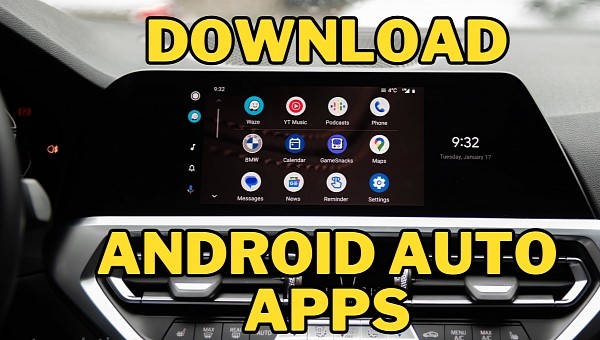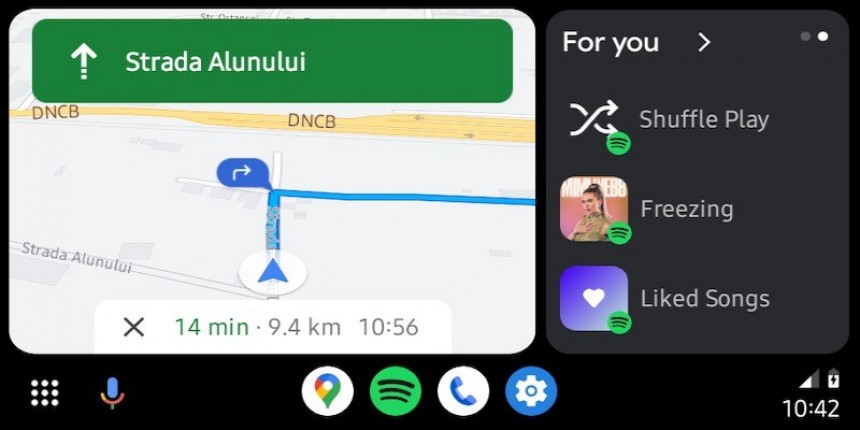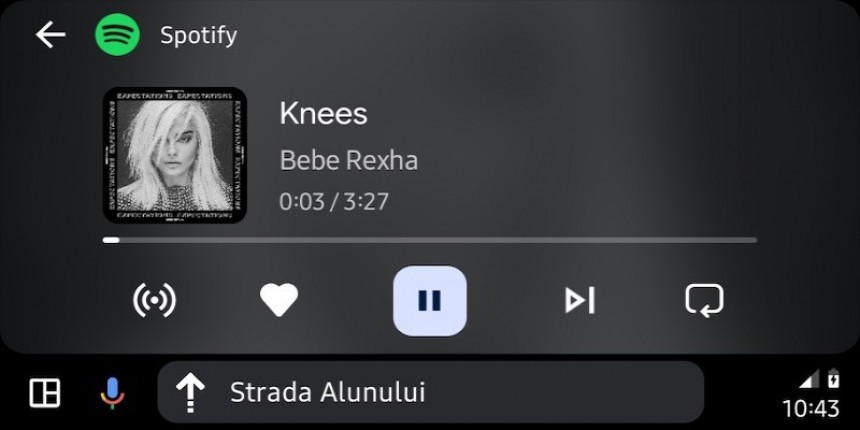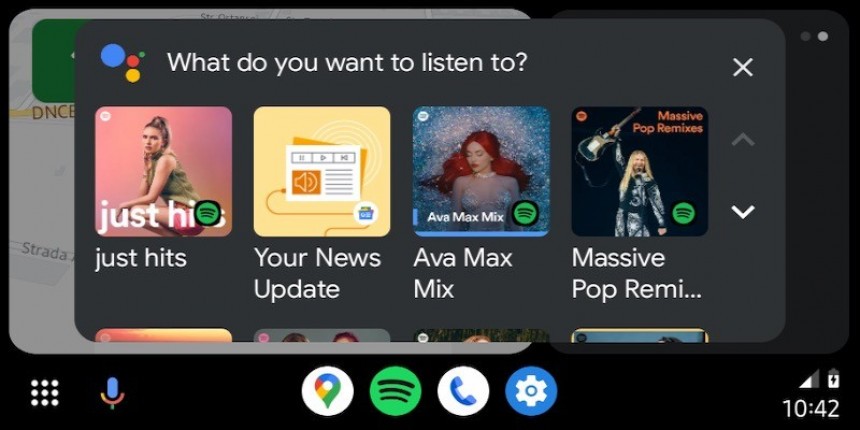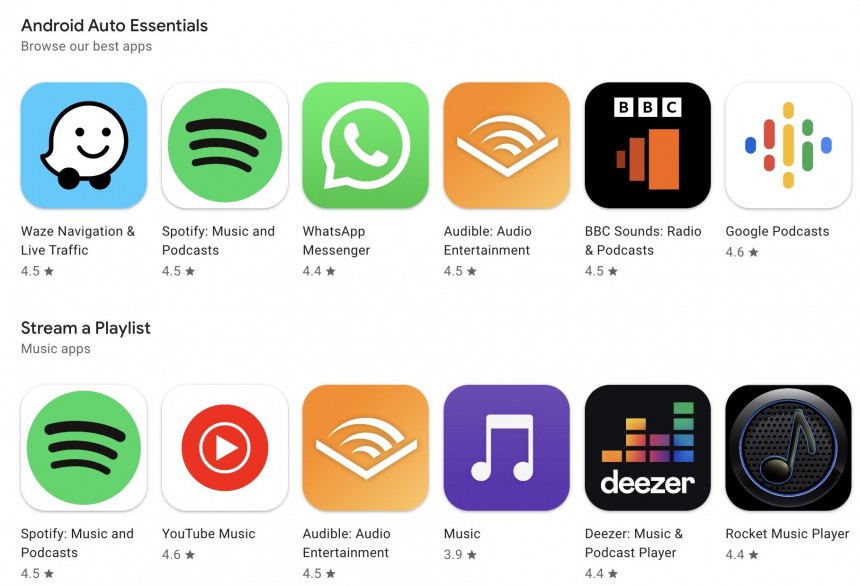The main benefit of having the mobile interface mirrored on the larger screen in the cabin is the more convenient way of app interaction while driving.
The voice command integration allows users to control their apps without looking at the screen, therefore reducing distraction behind the wheel.
By default, most Android devices are fitted with a series of pre-loaded apps offering Android Auto compatibility. Google Maps is the default navigation app, so Android Auto can already provide route guidance out of the box.
Android Auto also supports third-party applications. As such, users can access their favorite services even when the mobile device is connected to the Android Auto head unit in their cars.
By design, apps running on Android Auto use Google templates that eventually help provide a unified experience in the car.
For example, all music apps offer a similar “now playing” interface, so when Google makes a change to the default template, the update isn’t limited to a specific application.
Listening to music on Spotify and YouTube Music is therefore a similar experience, though eventually, the difference is made by the content available on the two apps and other unique features.
This means you can’t install any apps on the head unit itself, as the entire experience is powered by the mobile device.
Compared to Android Auto, Android Automotive is running at the car hardware level. The platform does not require a mobile device to run, and it is only available in vehicles where it’s installed from the factory. Getting Android Automotive in a car where it’s not already available is not possible.
Android Auto can also be installed in a vehicle that shipped without support for the app. An aftermarket head unit upgrade would provide drivers with either wired or wireless Android Auto support. The cheapest Android Auto head units only come with wired connectivity.
As a result, apps that run on Android Auto must initially be installed on the Android device. If the app comes with Android Auto support, it should show up in the car automatically.
In some cases, the apps might not be available on Android Auto if they are disabled or suspended by the operating system. This happens if they eat up device resources. More often than not, simply running the mobile device on the smartphone restores them, eventually re-enabling them on Android Auto as well.
If you want to install a new Android Auto, you can download any application that supports the car experience from the Google Play Store. There’s no dedicated filter in this regard, but Google has created a special app group for Android Auto.
The “Android Auto Essentials” includes the most popular apps currently offered to drivers. Big names like Waze, Spotify, and WhatsApp are part of this group. Oddly enough, Google’s own YouTube Music is only highlighted in the music app category but is not considered an Android Auto essential.
Google recommends apps from categories like music, live news, sports, messaging, audiobooks, and podcasts. Worth knowing is that other apps also offer Android Auto support but are not listed on this page, so you can install them by searching for them directly on the Google Play Store.
Users must set up apps on mobile devices, and then the same configuration is carried over to Android Auto.
Google also shares a list of Android Automotive apps on the same page, but this could eventually make things more confusing for beginners. Android Automotive apps can also be installed directly from the car using the pre-loaded Google Play Store. As explained earlier, Android Automotive is the upgraded version of Android Auto and does not require a mobile device to run. Some Android Automotive apps might not run on Android Auto.
Messaging apps that run on Android Auto, such as WhatsApp and Telegram, don’t come with a conversational interface similar to the one on mobile devices. The messaging experience is powered by Google Assistant, which is in charge of reading incoming messages and sending replies. As such, the application runs entirely on the mobile device, so you are only notified when you receive a message. Users are not allowed to type text in these apps from the Android Auto display.
Google’s recommended Android Auto app collection does not include a navigation app group. The only highlighted name is Waze, but Android Auto users can also install a series of alternatives, including Sygic GPS Navigation and HERE WeGo.
By default, most Android devices are fitted with a series of pre-loaded apps offering Android Auto compatibility. Google Maps is the default navigation app, so Android Auto can already provide route guidance out of the box.
Android Auto also supports third-party applications. As such, users can access their favorite services even when the mobile device is connected to the Android Auto head unit in their cars.
The unified app experience
Android apps must be updated specifically to support Android Auto. This means not all apps that are available on your mobile device can also run in the car when the phone is connected to a head unit.By design, apps running on Android Auto use Google templates that eventually help provide a unified experience in the car.
For example, all music apps offer a similar “now playing” interface, so when Google makes a change to the default template, the update isn’t limited to a specific application.
Listening to music on Spotify and YouTube Music is therefore a similar experience, though eventually, the difference is made by the content available on the two apps and other unique features.
Downloading Android Auto apps
Given Android Auto is essentially the mobile UI mirrored to the dashboard screen, the apps you see in the car are still running on the smartphone.This means you can’t install any apps on the head unit itself, as the entire experience is powered by the mobile device.
Compared to Android Auto, Android Automotive is running at the car hardware level. The platform does not require a mobile device to run, and it is only available in vehicles where it’s installed from the factory. Getting Android Automotive in a car where it’s not already available is not possible.
Android Auto can also be installed in a vehicle that shipped without support for the app. An aftermarket head unit upgrade would provide drivers with either wired or wireless Android Auto support. The cheapest Android Auto head units only come with wired connectivity.
In some cases, the apps might not be available on Android Auto if they are disabled or suspended by the operating system. This happens if they eat up device resources. More often than not, simply running the mobile device on the smartphone restores them, eventually re-enabling them on Android Auto as well.
If you want to install a new Android Auto, you can download any application that supports the car experience from the Google Play Store. There’s no dedicated filter in this regard, but Google has created a special app group for Android Auto.
The “Android Auto Essentials” includes the most popular apps currently offered to drivers. Big names like Waze, Spotify, and WhatsApp are part of this group. Oddly enough, Google’s own YouTube Music is only highlighted in the music app category but is not considered an Android Auto essential.
Google recommends apps from categories like music, live news, sports, messaging, audiobooks, and podcasts. Worth knowing is that other apps also offer Android Auto support but are not listed on this page, so you can install them by searching for them directly on the Google Play Store.
Users must set up apps on mobile devices, and then the same configuration is carried over to Android Auto.
Messaging apps that run on Android Auto, such as WhatsApp and Telegram, don’t come with a conversational interface similar to the one on mobile devices. The messaging experience is powered by Google Assistant, which is in charge of reading incoming messages and sending replies. As such, the application runs entirely on the mobile device, so you are only notified when you receive a message. Users are not allowed to type text in these apps from the Android Auto display.
Google’s recommended Android Auto app collection does not include a navigation app group. The only highlighted name is Waze, but Android Auto users can also install a series of alternatives, including Sygic GPS Navigation and HERE WeGo.
